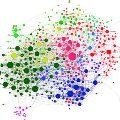This paper presents a novel methodology that uses surrogate models in the form of neural networks to reduce the computation time of simulation-based optimization of a reference trajectory. Simulation-based optimization is necessary when there is no analytical form of the system accessible, only input-output data that can be used to create a surrogate model of the simulation. Like many high-fidelity simulations, this trajectory planning simulation is very nonlinear and computationally expensive, making it challenging to optimize iteratively. Through gradient descent optimization, our approach finds the optimal reference trajectory for landing a hypersonic vehicle. In contrast to the large datasets used to create the surrogate models in prior literature, our methodology is specifically designed to minimize the number of simulation executions required by the gradient descent optimizer. We demonstrated this methodology to be more efficient than the standard practice of hand-tuning the inputs through trial-and-error or randomly sampling the input parameter space. Due to the intelligently selected input values to the simulation, our approach yields better simulation outcomes that are achieved more rapidly and to a higher degree of accuracy. Optimizing the hypersonic vehicle's reference trajectory is very challenging due to the simulation's extreme nonlinearity, but even so, this novel approach found a 74% better-performing reference trajectory compared to nominal, and the numerical results clearly show a substantial reduction in computation time for designing future trajectories.
翻译:本文提出了一种新的方法,使用神经网络作为代理模型,以减少参考轨迹的基于仿真的优化的计算时间。当系统没有解析形式可用时,只有可用于创建仿真的代理模型的输入-输出数据时,基于仿真的优化是必需的。像许多高保真仿真一样,这种轨迹规划仿真非常非线性且计算代价昂贵,使得迭代优化变得具有挑战性。通过梯度下降优化,我们的方法寻找最优的参考轨迹以使高超声速飞行器落地。与先前文献中用于创建代理模型的大型数据集相比,我们的方法旨在最小化梯度下降优化器所需的仿真执行次数。我们的方法显示出比手动调整输入的标准做法或随机采样输入参数空间更高的效率。由于模拟的输入值是经过智能选择的,因此我们的方法可以更快、更准确地得出更好的仿真结果。由于仿真的极端非线性,优化高超声速飞行器参考轨迹非常具有挑战性,但即使如此,这种新颖的方法与名义相比找到了一个性能更好的参考轨迹,数值结果清楚地显示出设计未来轨迹的计算时间的显著减少。

